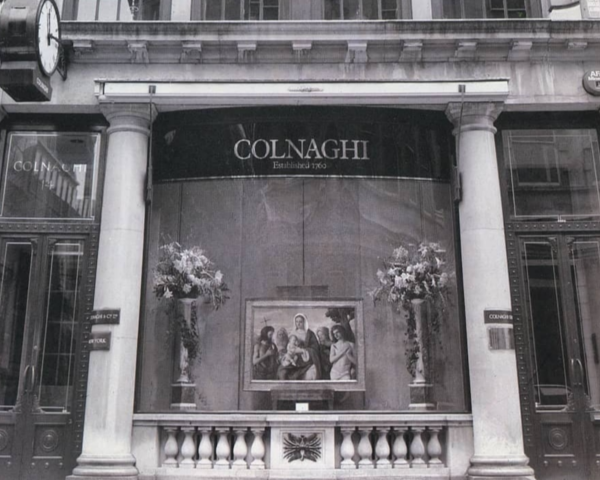
The years between 1880 and the outbreak of the Second World War were a golden age of international art dealing when, as a result of the break-up of the great collections of the European aristocracy and the rise of a new plutocracy with unprecedented buying power and a great appetite for art, extraordinary masterpieces came on to the art market in a way not seen since the Napoleonic era.
Many of these found their way across the Atlantic into the hands of collectors such as Isabella Stewart Gardner, Henry Clay Frick, Andrew Mellon, and Arabella and Henry Huntington, whose collections were turned into private museums, or, in the case of Andrew Mellon, P.A.B Widener and Samuel Kress, laid the foundations of the great US public museums, passing through the hands of networks of dealers, decorators, advisers and other intermediaries.
Colnaghi’s two-day symposium in the gallery at 26 Bury Street examined this extraordinary chapter in the history of the art market. Talks drew upon the expertise of some of the most distinguished scholars in the field
from the Getty Research Institute, the Warburg Institute, the Sorbonne and
other leading academic institutions. Themes and topics explored included the development of transatlantic art-dealing partnerships
such as Knoedler and Colnaghi and the ways in which their businesses
were financed through joint accounts; the role played by antique dealers
Charles Duveen, Edouard Jonas and Jacques Seligmann, the architect
Richard Morris Hunt and the furniture-making firm of Alfred Beurdeleys in
supplying the furnishings for the plutocratic mansions of the Gilded Age;
J. Pierpont Morgan as a collector of Italian gold-ground paintings; the
taste for malachite in the Gilded Age; the career of William P. Moore as a
dealer in Asian art and the influence on the contemporary silver produced
by Tiffany’s; Kenneth Clark’s role as an adviser to Calouste Gulbenkian;
Buenos Aires in the Gilded Age; and dealing in and collecting ‘classic’
modern French art in the interwar period.
TICKETS
Tickets were obtained through a donation to the Colnaghi Foundation. Drinks and light refreshments were provided. Online attendees were emailed a watch link, ahead of the conference.
To request a timeline of talks, tickets, or for more information, please email: shortcourse@colnaghifoundation.org
DAY 1 (4th NOVEMBER)
09:00-09:30 Registration
09:30-9:40 Welcome
09:40-09:50 Introduction to the Symposium (Professor Jeremy Howard, Head of Academic Projects, Colnaghi)
AM | The Gilded Age Art Market-Early Years
09:50-10:20 Dr Barbara Bryant (Independent Art Historian), “An Ambitious Dealer”: Stephen Gooden at 57 Pall Mall in the 1890s
10:25-10:55 Dr Elisa Camporeale (Istituto Lorenzo de’Medici), ‘Against the Mainstream’: Morgan’s Primitives
10:55-11:15 Coffee
‘Gilded Interiors’: antique dealers, decorators, and architects in the Gilded Age
11:15-11:45 Adriana Turpin (IESA), Charles Duveen and the Furnishing of Coe Hall, Oyster Bay
11:50-12:20 Sam Watters (independent author and columnist), Richard Morris Hunt: Gilding the American Interior - The furnishing and supply of works of art for William K Vanderbilt House
12:25-1:00 Discussion
PM |Transatlantic partnerships and American Collecting
2:15 – 2:45 Dr Camille Mesdagh, Alfred Beurdeley - The Transatlantic expansion of a Parisian furniture maker and dealership in the 1890s
2:50-3:20 Dr Barbara Lasic (Sothebys Institute), A transatlantic hybrid: Edouard Jonas (1883-1961), Art Dealer and Curator
3:25-3:55 Dr Rebecca Tilles, An Exceptional Transatlantic Partnership - Seligmann and Co and George and Florence Blumenthal
4:00-4:20 Tea Break
4:25-4:55 Dr Anne Helmreich (Associate Director, Getty Foundation) and Dr Sandra van Ginhoven (Head, Project for the Study of Collecting and Provenance, Getty Research Institute), Unsettled Accounts: Joint ownership in the transatlantic art trade during the Gilded Age
5:00-5:45 Closing Discussion
Drinks
DAY 2 (5TH NOVEMBER)
09:00-09.30 Coffee and Registration
09:30-9:40 Welcome
09:40-09:50 Introduction to the second day of the conference (Professor Jeremy Howard, Head of Academic Projects, Colnaghi)
AM The Later Gilded Age
09:50-10:20 Dr Louise Arizzoli, A Gilded Age Collector: James Hazen Hyde (1876-1959) and the European Art Market (Paris, London, Rome)
10:25-10:55 Moira Ferguson (Tiffany Archives), William P. Moore, Tiffany’s and the New York Art Market
10:55-11:20 Coffee
Wider shores: The Gilded Age in Russia and Latin America
11:25-11:55 Dr Ludmilla Budrina, Demidoff malachites after the Demidoff era: Dealers, collectors, and the taste for malachites, in the Gilded Age art market
12-12:30 Florencia Rodríguez Giavarini (Universidad del Salvador, Buenos Aires), Buenos Aires in the Gilded Age. A Modern Metropolis Clings to Remnants of the Past
Adriana Turpin will compere questions for the morning session
12:30-13:00 Discussion
PM Young Scholars Research Forum
2:00-3:00 Three current PhD students present short papers (15-20 minutes each) based on their research
Paper 1: Sarah Coviello (PhD Candidate, Warburg Institute), The Art Market in the Gilded Age between London and Paris: Kenneth Clark as an Art Adviser to Calouste Gulbenkian
Paper 2: Susana Garcia (PhD candidate, Pantheon-Sorbonne), Collecting art from the Ancient Americas. Dealers and collectors between Paris, London and the United States at the turn of the 20th century
Paper 3: Flaminia Ferito, (PhD Candidate, PhD Student in Analysis and Management of Cultural Heritage, IMT – School for Advanced Studies Lucca), The dispersal of cultural property from the suppressed monasteries and convents in and near Rome: the case of the ciborium from the Church of Santo Stefano, Rome and its acquisition by the Metropolitan Museum, New York in 1909
The Later Gilded Age and Beyond
3:05-3:35 Dr Elizabeth Pergam, William F Davidson and the Westward Expansion of M. Knoedler & Co
3:40-4:10 Professor Robert Jensen (University of Kentucky), Beyond the Gilded Age: The Market for 'classic French modern' art during the Interwar Period